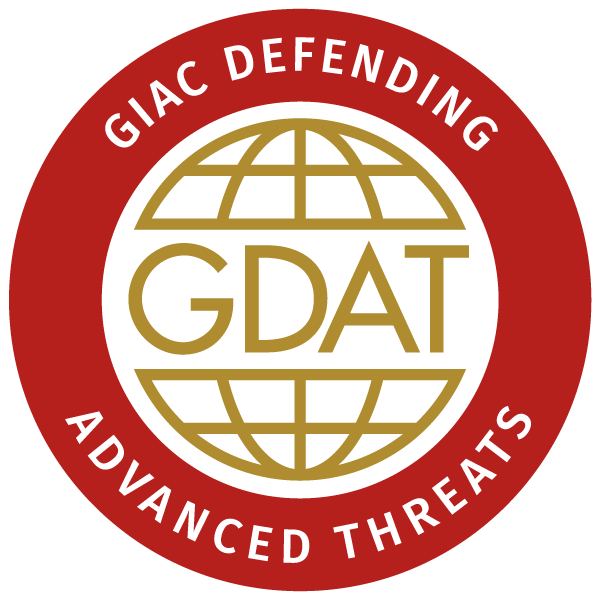Areas Covered
- Advanced persistent threat models and methods
- Detecting and preventing payload deliveries, exploitation, and post-exploitation activities
- Using cyber deception to gain intelligence for threat hunting and incident response
- Adversary Emulation
Who is GDAT for?
- All blue team personnel
- All red team personnel
- All purple team personnel
- Security architects
- IT administrators
Exam Format
- 1 proctored exam
- 75 questions
- 2 hours
- Minimum passing score of 70%
Delivery
NOTE: All GIAC Certification exams are web-based and required to be proctored. There are two proctoring options: remote proctoring through ProctorU, and onsite proctoring through PearsonVUE. Click here for more information.
GIAC certification attempts will be activated in your GIAC account after your application has been approved and according to the terms of your purchase. Details on delivery will be provided along with your registration confirmation upon payment. You will receive an email notification when your certification attempt has been activated in your account. You will have 120 days from the date of activation to complete your certification attempt.
Exam Certification Objectives & Outcome Statements
- Active Directory/Domains The candidate will demonstrate knowledge of the following domain topics as they relate to information security: authentication basics, Kerberos, common attacks against domains, and detecting attacks against domains.
- Administrative Access The candidate will exhibit a proficiency in topics related to the impacts of privilege escalation, and the importance of concepts related to "least privilege" methodologies.
- Adversary Emulation The candidate will demonstrate knowledge of the following adversary emulation topics: basic concepts, common tools used, and key technical controls to consider.
- Application Exploitation The candidate will be able to summarize how; combining the software development lifecycle with threat modeling, employing proper patch management strategies, and other exploit mitigation techniques can improve the security of an organization against application exploitation.
- Data Exfiltration The candidate will be able to compare and contrast common exfil strategies, summarize strategies for detecting C2 channels, and discuss pros and cons of performing deception techniques as a possible attack target.
- Installation The candidate will be able to compare and contrast common persistence strategies and how organizations can be protected against them.
- Lateral Movement The candidate will be able to appraise different lateral movement strategies, as well as strategies and controls for detecting and preventing the successful execution of malicious payloads.
- Payload Delivery The candidate will be able to appraise different payload delivery strategies, as well as strategies and controls focused on minimizing the likelihood of the successful delivery of malicious payloads.
- Payload Execution The candidate will be able to appraise different payload execution strategies, as well as strategies and controls for detecting and preventing the successful execution of malicious payloads.
- Reconnaissance, Threat Handling, and Incident Response The candidate will exhibit a proficiency in the following exploitation topics: fundamental reconnaissance, threat hunting strategies, and the incident response process.
Other Resources
- Training is available in a variety of modalities including live training and OnDemand
- Practical work experience can help ensure that you have mastered the skills necessary for certification
- College level courses or self paced study through another program or materials may meet the needs for mastery.
- Get information about the procedure to contest exam results.
Practice Tests
- These tests are a simulation of the real exam allowing you to become familiar with the test engine and style of questions.
- Practice exams are a gauge to determine if your preparation methods are sufficient.
- The practice bank questions are limited so you may encounter the same question on practice tests when multiple practice tests are purchased.
- Practice exams never include actual exam questions.
- Purchase a GDAT practice test here.
- GIAC recommends leveraging additional study methods for test preparation.



